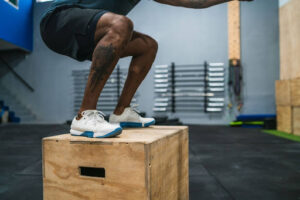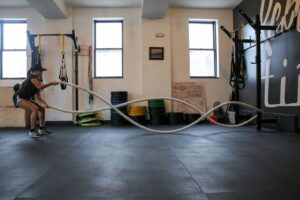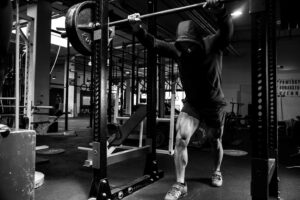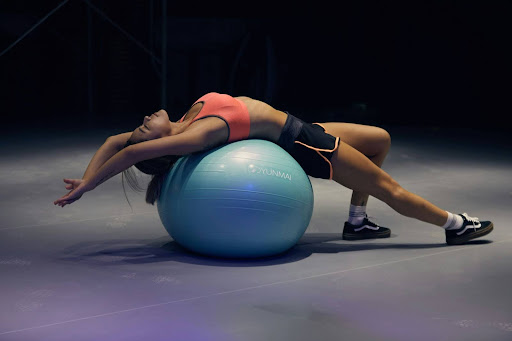
Whether you are starting your fitness journey or you are a master at it, an exercise ball can be your go to tool in the gym or for your home workout. You can use the same ball in multiple ways or perform varied exercise routines. The exercise ball, also known as stability or Swiss ball, is one of the most versatile fitness tools available today. Originally designed for physical therapy, it has evolved into a staple in both professional and home workout routines. Its ability to engage multiple muscle groups simultaneously makes it an excellent choice for anyone looking to enhance core strength, balance, flexibility, and overall fitness. Whether you are working out at home, in the gym, or on the go, the exercise ball can be seamlessly integrated into your routine to provide a challenging and effective workout.
What is an Exercise Ball?
An exercise ball is a large, inflatable ball made of soft, elastic material, typically PVC. The size of the ball usually ranges from 55 cm to 75 cm in diameter, with the appropriate size determined by your height. The exercise ball is popular due to its simple yet effective design, which allows for a wide range of exercises. It is a common tool in physical therapy, Yoga, Pilates, and general fitness because it can be used to improve strength, balance, and flexibility. Its popularity has only grown as more people recognize the benefits of incorporating it into both professional and home workouts.
Benefits of Using an Exercise Ball
Core Strengthening
One of the primary benefits of using an exercise ball is its ability to strengthen the core muscles. The unstable surface of the ball requires constant engagement of the abdominal, lower back, and oblique muscles to maintain balance. This constant engagement leads to a stronger, more stable core, which is essential for overall fitness and injury prevention.
Examples of Core Exercises
- Ball Planks: Place your forearms on the ball and extend your legs behind you. Hold this position, keeping your core tight and body straight.
- Ball Crunches: Sit on the ball and roll down until your lower back is supported. Perform crunches by lifting your upper body towards your knees.
Improving Balance and Stability
Balancing on an exercise ball is a great way to improve overall stability and coordination. The ball’s unstable surface challenges your balance, forcing you to engage multiple muscle groups to stay upright.
Examples of Balance Exercises
- Seated Ball Balance: Sit on the ball with your feet flat on the ground. Lift one foot off the floor and hold for a few seconds, then switch sides.
- Standing Leg Lifts: Stand behind the ball and place one foot on it. Lift your other leg and hold the position to improve balance.
Enhancing Flexibility
The exercise ball is also an excellent tool for enhancing flexibility. It allows for a greater range of motion in stretches, helping to lengthen and loosen tight muscles.
Examples of Flexibility Exercises
- Backbends: Lie on your back over the ball with your feet flat on the ground. Allow your back to arch over the ball, stretching your spine and chest.
- Hamstring Stretches: Sit on the ball with your legs extended in front of you. Reach towards your toes to stretch your hamstrings.
Strength Training
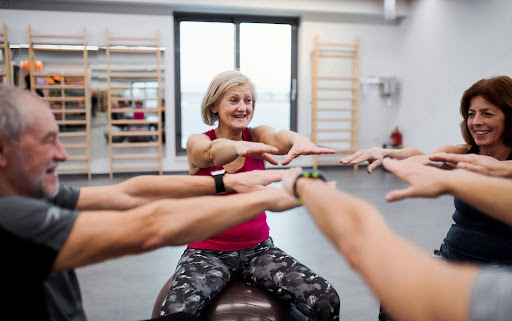
Incorporating the exercise ball into strength training exercises can add a new level of challenge and variety to your workouts. The unstable surface forces your muscles to work harder to maintain balance, increasing the intensity of traditional strength exercises.
- Wall Squats: Place the ball between your lower back and a wall. Perform squats by bending your knees and lowering your body while keeping the ball pressed against the wall.
- Ball Push-Ups: Place your hands on the ball and perform push-ups. The unstable surface increases the difficulty and engages your core.
Posture Correction
Using an exercise ball regularly can also help improve your posture. Sitting on the ball as a chair encourages proper spinal alignment and engages your core muscles, promoting better posture during daily activities.
Tips for Using the Ball as a Chair
- Ensure the ball is the right size for your height. Your knees should be at a 90-degree angle when sitting.
- Sit with your feet flat on the floor and keep your back straight, engaging your core to maintain balance.
Exercise Balls for Pregnant Women
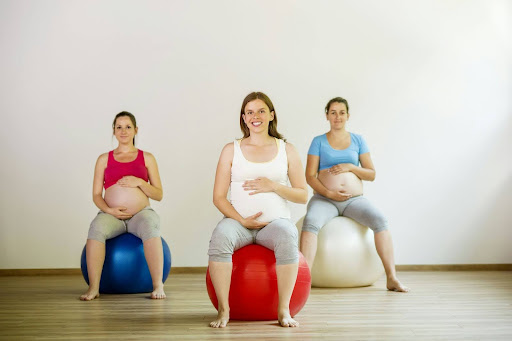
During pregnancy, an exercise ball can be a supportive tool for comfort and fitness. Sitting on the ball helps improve posture and alleviate lower back pain by engaging your core and promoting proper spinal alignment. Gentle bouncing or pelvic tilts on the ball can also relieve tension in the hips and lower back, making it easier to stay active as your body changes.
During labour, the exercise ball can be invaluable in helping you manage contractions and find comfortable positions. Sitting on the ball and gently rocking or bouncing can encourage the baby to move into an optimal birthing position, while also helping to open the pelvis. Leaning forward on the ball while on your knees or standing can take pressure off your lower back and allow you to relax between contractions.
Postpartum, the exercise ball continues to be useful in regaining strength and flexibility. You can start with gentle exercises, like pelvic tilts or seated marches, to rebuild core muscles and stabilise the pelvic floor. As you recover, the ball can also be used for light stretching and relaxation, helping you regain your balance and strength while bonding with your baby.
Exercise Balls for Elderlies
For elderly individuals, an exercise ball offers a gentle and effective way to maintain strength, balance, and flexibility. Using the ball for seated exercises, such as seated marches or gentle leg lifts, can help improve circulation and strengthen the lower body without placing undue stress on the joints. The ball’s instability challenges core muscles, promoting better posture and stability, which are crucial for preventing falls. Simple stretches on the ball can also enhance flexibility, easing stiffness and improving overall mobility. Incorporating the exercise ball into a routine allows seniors to stay active in a safe, low-impact manner, supporting both physical health and independence.
Here are the advantages of using an exercise ball for elderly individuals:
- Improves Balance and Stability: The instability of the ball helps strengthen core muscles, enhancing balance and reducing the risk of falls.
- Enhances Flexibility: Gentle stretching exercises on the ball can help improve flexibility, easing joint stiffness and increasing range of motion.
- Supports Low-Impact Exercise: The ball allows for low-impact movements that are easy on the joints, making it ideal for seniors with arthritis or mobility issues.
- Promotes Better Posture: Sitting on the ball encourages proper spinal alignment and engages the core, which can improve posture and reduce back pain.
- Strengthens Muscles: Simple exercises like seated leg lifts and marches on the ball help maintain muscle strength in the legs and core.
- Increases Circulation: Light movements on the ball can improve blood flow, which is beneficial for overall health and can help prevent swelling in the legs.
- Boosts Confidence in Physical Activity: The ball provides a safe, supportive way for seniors to stay active, which can boost confidence and encourage regular exercise.
Incorporating the Exercise Ball into Your Home Workout Routine
Setting Up a Home Workout Space
Creating a dedicated workout space at home can help you stay consistent with your fitness routine. When choosing an exercise ball, make sure it is the right size for your height. Additionally, select a safe and spacious area free of obstacles to perform your exercises.
Sample Home Workout Plan
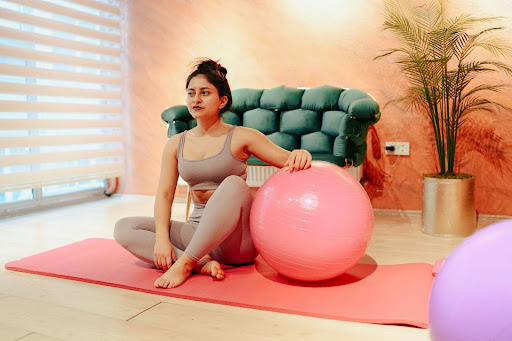
Here’s a full-body workout routine using an exercise ball, suitable for all fitness levels:
- Warm-Up: 5-10 minutes of light cardio (e.g., jogging in place or jumping jacks).
- Ball Planks: 3 sets of 30 seconds.
- Wall Squats: 3 sets of 15 reps.
- Ball Crunches: 3 sets of 20 reps.
- Seated Ball Balance: 3 sets of 10 reps per leg.
- Hamstring Stretches: 3 sets of 15-30 seconds per leg.
Adjustments for Different Fitness Levels
- Beginner: Start with shorter plank holds and fewer reps. Focus on mastering the form.
- Intermediate: Increase the duration of planks and add more reps to each exercise.
- Advanced: Incorporate additional exercises such as ball push-ups and increase the intensity by adding weights.
Using the Exercise Ball at the Gym
Advantages of Using the Exercise Ball in a Gym Setting
The gym offers access to a variety of fitness accessories that can be combined with the exercise ball for a more comprehensive workout. For example, you can use dumbbells or resistance bands along with the ball to target different muscle groups more effectively.
Gym Workout Routine with an Exercise Ball
Here’s a sample gym workout routine focusing on full-body conditioning:
- Warm-Up: 5-10 minutes on a cardio machine (e.g., treadmill or stationary bike).
- Ball Push-Ups: 3 sets of 10-15 reps.
- Ball Russian Twists with a Dumbbell: 3 sets of 20 reps.
- Ball Leg Curls with Hamstring Focus: 3 sets of 15 reps.
- Standing Ball Balance with Dumbbell Shoulder Press: 3 sets of 12 reps per arm.
Emphasis on Integration
This routine emphasises the integration of the exercise ball with other fitness equipment, enhancing both strength and stability while providing a well-rounded workout experience.
Incorporating the Exercise Ball into Anywhere Workouts
Portability and Convenience
One of the exercise ball’s greatest advantages is its portability. It can be easily deflated, making it convenient to carry and use anywhere, whether you are travelling or simply heading to a nearby park.
Quick Workout Ideas for On-the-Go
Here are some simple exercises you can do in any location:
- Ball Rollouts: Kneel on the ground with the ball in front of you. Place your forearms on the ball and slowly roll it forward while keeping your core tight.
- Ball Bridges: Lie on your back with your feet on the ball. Lift your hips off the ground, squeeze your glutes, and hold for a few seconds before lowering.
- Seated Ball Stretch: Sit on the ball and reach your arms overhead, stretching your sides and back.
Stretching and Mobility Routines
When on the go, focus on using the exercise ball for stretching and mobility to maintain fitness. The ball is perfect for loosening tight muscles after long periods of sitting or travelling.
Tips for Maximising the Benefits of an Exercise Ball
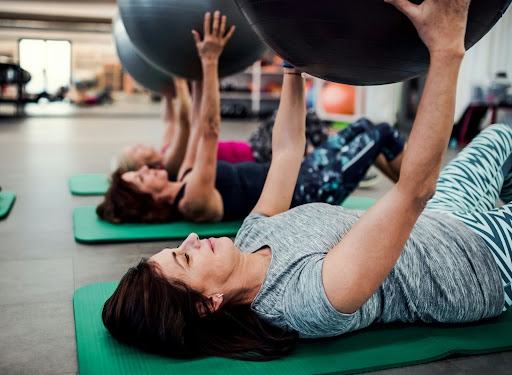
Consistency is Key
To see the long-term benefits of using an exercise ball, consistency is crucial. Make it a regular part of your fitness routine, whether you are at home, in the gym, or travelling.
Combining with Other Fitness Equipment
Pair the exercise ball with resistance bands, weights, or a yoga mat to create a more varied and challenging workout. This combination can help target different muscle groups and enhance overall fitness.
Safety Precautions
Always use proper techniques to avoid injuries. Ensure the ball is properly inflated and stable before performing exercises. Be mindful of the surface you are using the ball on; a non-slip mat can provide extra stability.
The exercise ball is an incredibly versatile and effective fitness tool that can enhance any workout routine.
Its ability to improve core strength, balance, flexibility, and posture makes it a valuable addition to your fitness regimen. At Leewarehouse we think, that whether you are working out at home, in the gym, or on the go, the exercise ball can be seamlessly integrated into your routine, offering a fun and challenging way to stay fit. Make the exercise ball a staple in your workouts, and you will enjoy the many benefits it has to offer.

